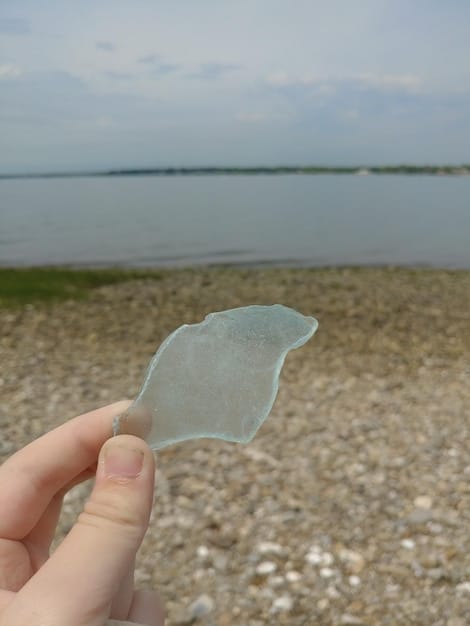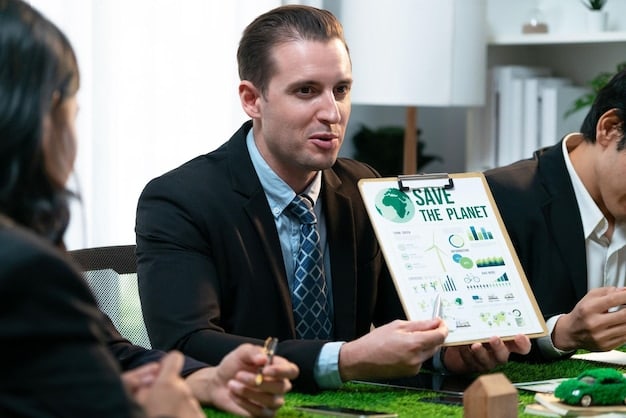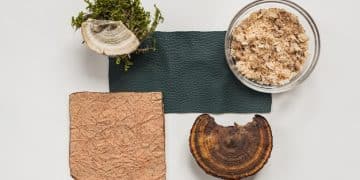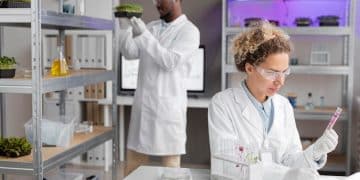Sustainable Packaging: US Companies Cutting Plastic Waste by 35%

Sustainable packaging innovations are transforming how US companies operate, driving a 35% reduction in plastic waste through new materials and innovative designs, marking a significant shift towards environmental responsibility and circular economy practices.
Are you aware of the groundbreaking strides US companies are making in sustainable packaging innovations? Witnessing a remarkable 35% reduction in plastic waste, these pioneering efforts are reshaping industries and redefining environmental responsibility. Discover how new materials and forward-thinking strategies are leading the charge towards a greener future.
The Growing Crisis of Plastic Waste in the US
Plastic waste has become a pressing environmental issue, and the United States is no exception. Understanding the scale of the problem is the first step towards finding effective solutions. This section will explore the current state of plastic waste in the US and the urgent need for change.
The Sheer Volume of Plastic Waste
The US generates an enormous amount of plastic waste annually, contributing significantly to global pollution. This waste ends up in landfills, oceans, and natural habitats, causing long-term damage to ecosystems.
Environmental Impact of Plastic
Plastic pollution has dire consequences for wildlife, marine life, and human health. Microplastics contaminate food chains, and the decomposition of plastics releases harmful chemicals into the environment.
- Plastic waste accumulates in landfills, taking up valuable space.
- Ocean plastic harms marine animals through entanglement and ingestion.
- Microplastics contaminate soil and water sources, affecting agriculture and drinking water.
The environmental impact of plastic waste underscores the importance of sustainable packaging innovations. Companies are increasingly aware of their responsibility to reduce their plastic footprint and adopt more eco-friendly alternatives.
Innovative Materials Leading the Charge
One of the most promising approaches to reducing plastic waste is the development and adoption of innovative, sustainable materials. These materials offer viable alternatives to traditional plastics, with significantly reduced environmental impact. Here, we’ll explore some of the most exciting developments in this area.

Mushroom Packaging: A Natural Alternative
Mushroom packaging, made from mycelium (the root structure of mushrooms), is gaining popularity as a biodegradable alternative to polystyrene. It’s strong, lightweight, and compostable, making it an excellent choice for protecting fragile items during shipping.
Seaweed-Based Packaging: Ocean-Friendly Solutions
Seaweed-based packaging is another innovative option that is both biodegradable and compostable. Seaweed is a renewable resource that doesn’t require land or freshwater to grow, making it a highly sustainable choice.
- Mushroom packaging is ideal for electronics and furniture protection.
- Seaweed packaging can be used for food and cosmetic products.
- Both materials decompose naturally, enriching the soil with nutrients.
The shift towards these innovative materials represents a significant step forward in sustainable packaging innovations. As more companies adopt these alternatives, the demand for traditional plastics will decrease, leading to a reduced environmental burden.
US Companies at the Forefront of Sustainable Packaging
Several US companies are leading the way in adopting sustainable packaging solutions and setting new industry standards. By investing in research, development, and implementation of eco-friendly practices, these companies are demonstrating that sustainability can be both environmentally and economically beneficial.
Case Study: Company A’s Transition to Mushroom Packaging
Company A, a leading electronics manufacturer, has successfully transitioned a significant portion of its packaging to mushroom-based materials. This move has not only reduced their plastic waste but also enhanced their brand image among environmentally conscious consumers.
Case Study: Company B’s Use of Seaweed Pouches
Company B, a cosmetics brand, has embraced seaweed pouches for its single-use products, significantly reducing its reliance on plastic. These pouches are biodegradable and compostable, aligning with the company’s commitment to sustainability.
- These companies are demonstrating that sustainable packaging can be cost-effective.
- Consumer response to eco-friendly packaging has been overwhelmingly positive.
- More companies are expected to follow suit as awareness grows.
These examples highlight the growing trend of sustainable packaging innovations in the US. By showcasing successful implementations, these companies inspire others to take action and contribute to a more sustainable future.
The Role of Government and Regulations
Government regulations and policies play a crucial role in promoting sustainable packaging practices. By setting standards, providing incentives, and enforcing compliance, governments can drive significant change and encourage companies to adopt eco-friendly solutions. This section will examine the current regulatory landscape and its impact on the packaging industry.

Current Regulations on Plastic Packaging
Several states have implemented regulations on single-use plastics, including bans on plastic bags and restrictions on polystyrene containers. These measures aim to reduce plastic waste and encourage the use of reusable alternatives.
Incentives for Sustainable Packaging
Governments also offer incentives to companies that adopt sustainable packaging practices, such as tax credits, grants, and subsidies. These incentives can help offset the initial costs of switching to eco-friendly materials and processes.
- Regulations create a level playing field for companies, ensuring compliance with environmental standards.
- Incentives encourage innovation and investment in sustainable solutions.
- Public awareness campaigns promote responsible consumption and waste management.
Effective government policies are essential for fostering a culture of sustainability and driving the adoption of sustainable packaging innovations. By working together with businesses and consumers, governments can create a more sustainable and resilient economy.
Challenges and Obstacles in the Adoption of Sustainable Packaging
Despite the growing awareness and momentum behind sustainable packaging, several challenges and obstacles remain. Overcoming these barriers is crucial for widespread adoption and achieving significant reductions in plastic waste. This section will explore some of the key challenges and potential solutions.
Cost Considerations
One of the primary barriers to adopting sustainable packaging is the perceived higher cost compared to traditional plastics. However, as demand for eco-friendly materials increases, prices are expected to become more competitive.
Infrastructure Limitations
Another challenge is the lack of adequate infrastructure for recycling and composting sustainable packaging materials. Investing in infrastructure development is essential for ensuring that these materials are properly processed and reused.
- Companies need to conduct thorough cost-benefit analyses to assess the long-term value of sustainable packaging.
- Governments and businesses must collaborate to improve recycling and composting infrastructure.
- Consumer education is vital for promoting proper disposal and encouraging participation in recycling programs.
Addressing these challenges is essential for unlocking the full potential of sustainable packaging innovations. By investing in research, infrastructure, and education, we can create a more sustainable and resilient economy.
The Future of Sustainable Packaging in the US
The future of sustainable packaging in the US looks promising, with ongoing innovations, increasing consumer demand, and supportive government policies. As technology advances and awareness grows, we can expect to see even more significant reductions in plastic waste and a shift towards a circular economy. This section will explore the trends and developments that are shaping the future of sustainable packaging.
Emerging Technologies and Innovations
New technologies, such as advanced bioplastics and smart packaging solutions, are poised to revolutionize the packaging industry. These innovations offer enhanced performance, improved recyclability, and reduced environmental impact.
Consumer Demand for Sustainable Products
Growing consumer awareness and demand for sustainable products are driving companies to adopt eco-friendly packaging practices. Consumers are increasingly willing to pay a premium for products that align with their values, creating a market incentive for sustainability.
- Continued investment in research and development is essential for driving innovation.
- Collaboration between businesses, governments, and consumers is crucial for creating a sustainable ecosystem.
- Education and awareness campaigns can promote responsible consumption and waste management.
By embracing these trends and working together, we can create a future where sustainable packaging innovations are the norm, not the exception. This will not only reduce plastic waste but also create a more sustainable and resilient economy for generations to come.
| Key Point | Brief Description |
|---|---|
| 🌱 Innovative Materials | Mushroom and seaweed packaging as alternatives to plastic. |
| 🏢 US Company Leadership | Companies adopting sustainable packaging to reduce waste. |
| 📜 Government Role | Regulations and incentives promoting eco-friendly packaging. |
| 💰 Overcoming Challenges | Addressing costs and infrastructure limitations. |
FAQ
▼
The key drivers include increasing consumer awareness, stricter government regulations, and the growing recognition of the environmental and economic benefits of reducing plastic waste.
▼
Mushroom packaging is made from mycelium, a biodegradable material that replaces polystyrene in protecting fragile items. It decomposes naturally, avoiding landfill waste.
▼
Many US companies are switching to mushroom and seaweed-based packaging to reduce plastic use. These companies are also investing in recycling and composting programs.
▼
Companies often face higher initial costs and infrastructure limitations. Overcoming these hurdles requires investment, collaboration, and consumer support for eco-friendly alternatives.
▼
Governments set standards, offer incentives, and enforce compliance with environmental regulations. They also support research, development, and public awareness campaigns to promote eco-friendly practices.
Conclusion
The push for sustainable packaging innovations in the US is a critical step towards reducing plastic waste and promoting a more sustainable future. By embracing innovative materials, supporting leading companies, and advocating for effective government policies, we can collectively drive significant change and create a healthier planet for future generations.





